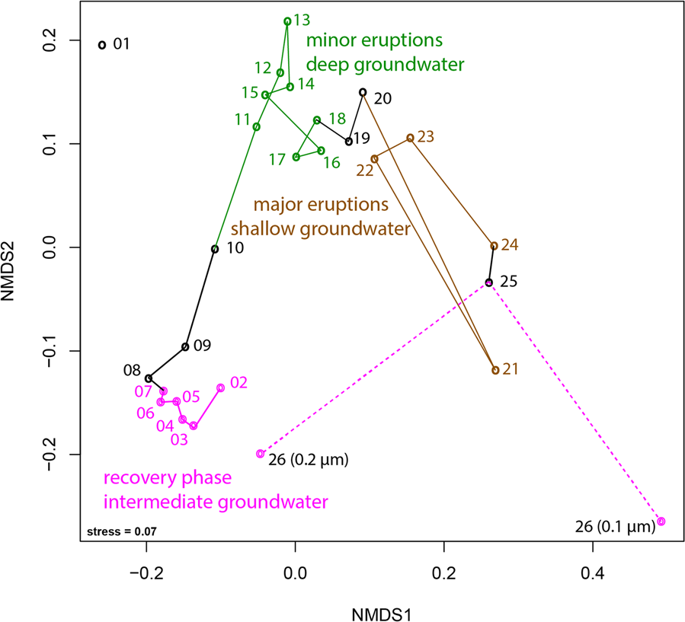Our official English website, www.x-mol.net, welcomes your feedback! (Note: you will need to create a separate account there.)
Lipid analysis of CO2-rich subsurface aquifers suggests an autotrophy-based deep biosphere with lysolipids enriched in CPR bacteria.
The ISME Journal ( IF 11.0 ) Pub Date : 2020-03-13 , DOI: 10.1038/s41396-020-0624-4 Alexander J Probst 1, 2 , Felix J Elling 3, 4 , Cindy J Castelle 1, 3 , Qingzeng Zhu 3 , Marcus Elvert 3 , Giovanni Birarda 5, 6 , Hoi-Ying N Holman 6 , Katherine R Lane 1 , Bethany Ladd 7, 8 , M Cathryn Ryan 7 , Tanja Woyke 9 , Kai-Uwe Hinrichs 3 , Jillian F Banfield 1
The ISME Journal ( IF 11.0 ) Pub Date : 2020-03-13 , DOI: 10.1038/s41396-020-0624-4 Alexander J Probst 1, 2 , Felix J Elling 3, 4 , Cindy J Castelle 1, 3 , Qingzeng Zhu 3 , Marcus Elvert 3 , Giovanni Birarda 5, 6 , Hoi-Ying N Holman 6 , Katherine R Lane 1 , Bethany Ladd 7, 8 , M Cathryn Ryan 7 , Tanja Woyke 9 , Kai-Uwe Hinrichs 3 , Jillian F Banfield 1
Affiliation

|
Sediment-hosted CO2-rich aquifers deep below the Colorado Plateau (USA) contain a remarkable diversity of uncultivated microorganisms, including Candidate Phyla Radiation (CPR) bacteria that are putative symbionts unable to synthesize membrane lipids. The origin of organic carbon in these ecosystems is unknown and the source of CPR membrane lipids remains elusive. We collected cells from deep groundwater brought to the surface by eruptions of Crystal Geyser, sequenced the community, and analyzed the whole community lipidome over time. Characteristic stable carbon isotopic compositions of microbial lipids suggest that bacterial and archaeal CO2 fixation ongoing in the deep subsurface provides organic carbon for the complex communities that reside there. Coupled lipidomic-metagenomic analysis indicates that CPR bacteria lack complete lipid biosynthesis pathways but still possess regular lipid membranes. These lipids may therefore originate from other community members, which also adapt to high in situ pressure by increasing fatty acid unsaturation. An unusually high abundance of lysolipids attributed to CPR bacteria may represent an adaptation to membrane curvature stress induced by their small cell sizes. Our findings provide new insights into the carbon cycle in the deep subsurface and suggest the redistribution of lipids into putative symbionts within this community.
中文翻译:

富含CO2的地下含水层的脂质分析表明,基于自养的深层生物圈具有富含CPR细菌的溶脂。
科罗拉多高原深处(美国)沉积物富含CO2的含水层包含大量未培养的微生物,包括候选的Pyla辐射(CPR)细菌,它们是无法合成膜脂质的推定共生体。这些生态系统中有机碳的起源尚不清楚,CPR膜脂质的来源仍然难以捉摸。我们从通过结晶间歇泉爆发而带到地面的深层地下水中收集细胞,对群落进行测序,并分析随时间推移的整个群落脂质组。微生物脂质的特征性稳定碳同位素组成表明,在深地下进行的细菌和古细菌CO2固定为居住在那里的复杂群落提供了有机碳。耦合的脂质组学-基因组分析表明,CPR细菌缺乏完整的脂质生物合成途径,但仍具有规则的脂质膜。因此,这些脂质可能源自其他社区成员,这些成员也通过增加脂肪酸不饱和度而适应高原位压力。归因于CPR细菌的异常高的溶血脂可能代表了对因其小细胞大小引起的膜曲率应力的适应。我们的发现为深部地下的碳循环提供了新的见解,并暗示了脂质在该群落中向假定的共生体的重新分布。归因于CPR细菌的异常高的溶血脂可能代表了对因其小细胞大小引起的膜曲率应力的适应。我们的发现为深部地下的碳循环提供了新的见解,并暗示了脂质在该群落中向假定的共生体的重新分布。归因于CPR细菌的异常高的溶血脂可能代表了对因其小细胞大小引起的膜曲率应力的适应。我们的发现为深部地下的碳循环提供了新的见解,并暗示了脂质在该群落中向假定的共生体的重新分布。
更新日期:2020-03-13
中文翻译:

富含CO2的地下含水层的脂质分析表明,基于自养的深层生物圈具有富含CPR细菌的溶脂。
科罗拉多高原深处(美国)沉积物富含CO2的含水层包含大量未培养的微生物,包括候选的Pyla辐射(CPR)细菌,它们是无法合成膜脂质的推定共生体。这些生态系统中有机碳的起源尚不清楚,CPR膜脂质的来源仍然难以捉摸。我们从通过结晶间歇泉爆发而带到地面的深层地下水中收集细胞,对群落进行测序,并分析随时间推移的整个群落脂质组。微生物脂质的特征性稳定碳同位素组成表明,在深地下进行的细菌和古细菌CO2固定为居住在那里的复杂群落提供了有机碳。耦合的脂质组学-基因组分析表明,CPR细菌缺乏完整的脂质生物合成途径,但仍具有规则的脂质膜。因此,这些脂质可能源自其他社区成员,这些成员也通过增加脂肪酸不饱和度而适应高原位压力。归因于CPR细菌的异常高的溶血脂可能代表了对因其小细胞大小引起的膜曲率应力的适应。我们的发现为深部地下的碳循环提供了新的见解,并暗示了脂质在该群落中向假定的共生体的重新分布。归因于CPR细菌的异常高的溶血脂可能代表了对因其小细胞大小引起的膜曲率应力的适应。我们的发现为深部地下的碳循环提供了新的见解,并暗示了脂质在该群落中向假定的共生体的重新分布。归因于CPR细菌的异常高的溶血脂可能代表了对因其小细胞大小引起的膜曲率应力的适应。我们的发现为深部地下的碳循环提供了新的见解,并暗示了脂质在该群落中向假定的共生体的重新分布。


























 京公网安备 11010802027423号
京公网安备 11010802027423号